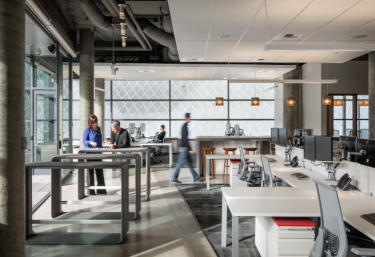|
Subscribe / Renew |
|
|
Contact Us |
|
| ► Subscribe to our Free Weekly Newsletter | |
| home | Welcome, sign in or click here to subscribe. | login |
Construction
| |

November 12, 2021
The future of tenant improvements calls for a long-term investment in company culture
Schuchart Construction
(Editor's note: This is the first of a two-part series covering the tenant improvement market. Part two will run on Nov. 18.)
In March of 2020 the world suddenly changed on many levels, including how and where we went to work each day. A global pandemic caused a pivot from a traditional office-based workforce to remote-first, and added the complexities of caregiver, teacher, and support network to many individuals' job descriptions.
Nearly two years later, as more employees are contemplating their return to offices and many businesses are looking to upgrade or expand their space, the conversation around the modern workplace must change: How can we be more intentional, building spaces that are equitable and accessible, and reflect the culture and values of the employees that inhabit them?
But while current events may have caused more organizations to view tenant improvement projects through a different lens, we aren't seeing a major swing in what these future workplaces ultimately look like. We're still building for density, and we're still upgrading for technology and energy efficiency. We don't need to change the types of spaces we're building. We need to change the process used to get there; and it starts by inviting the right people to the table.
TENANT IMPROVEMENTS ARE INVESTMENTS
As a commercial contractor that has helped businesses throughout the region reinvent their workspaces for more than 30 years, Schuchart's tenant improvement team has seen it all. We've learned that regardless of what the space looks like and how it functions, the key to success is in the project approach. It's not just about increasing space or adding new amenities. It's not simply a response to the latest office trends. A tenant improvement is a testament to an organization's values. It's an investment in their workplace culture, both where it is today and how they want it to evolve going forward.

But a tenant improvement is also a business investment. An office space must support day-to-day operations with the appropriate infrastructure and technology. Particularly in today's competitive hiring marketplace, it must retain current employees, and attract new ones. It needs to balance operational needs, company culture, and what employees value. When an organization struggles to get this right, it's because they aren't asking the right questions, and they don't include all their stakeholders and team members in the process.
EMPLOYEES ARE THE MOST VALUABLE STAKEHOLDERS
The office is where your employees connect, collaborate, and embrace and grow your company culture; they are your most valuable stakeholders when planning a tenant improvement. What do they want in their workspace? Are there certain aspects of their workflow that need to be accounted for?
On a recent tenant improvement for an accounting firm, we discovered during the buildout that the casework originally specified and approved through the submittal process wasn't designed to hold the size of paper that employees use, because the end user never saw the submittal or contract drawings. It may seem like a small revision, but it resulted in a last-minute change order to rebuild the casework; one that could have been avoided by reaching out to the user groups that would be operating in the space and asking the right questions.
When Schuchart began planning our own tenant improvement in 2013, we realized it was a chance for us to create an intentional workplace that better reflected and supported how we wanted to operate. In our previous office, the layout and flow kept our departments siloed and our employees less connected. Understanding that our employees value transparency in communication and sharing their collective knowledge, we knew that our new space had to have a more open floor plan with plenty of areas for creative exploration and collaboration. This included non-traditional benefits like the ability to open our office to industry partners and peers for events, strengthening our connection to the AEC community.
I know an open office doesn't work for everyone, but it was what we needed. And since moving into our space eight years ago, our teams have embraced the environment and continue to thrive.
DON'T UNDERESTIMATE YOUR CONTRACTOR'S INSIGHTS
Just as there's a tremendous benefit in talking to your employees about how your future workspace can support them, your general contractor can offer valuable insights too. They're intimately familiar with jurisdictional and permitting requirements, and current lead times on supplies and materials. They've built a multitude of amenities and space types, so they know what works and what doesn't. And if they've worked on other projects in the building, they've got unmatched knowledge of the existing infrastructure that may affect your tenant improvement.
Having this input early can help set expectations and establish a baseline budget and schedule so there aren't any surprises later.
One of our clients was interested in pursuing the Living Building Challenge with their tenant improvement, but they weren't fully aware of the requirements for a project like that. Since we were familiar with the LBC process, we were able to help the architect value engineer the design into a space that maintained the client's intent and vision as much as possible while staying within their budget. As the architect confirmed, “I don't go down the road creating something that isn't plausible. That way, I'm not selling clients on a vision that can't be executed. Having the contractor on board early in the process is my favorite way to do work.”
LOOKING AHEAD
As businesses continue to emerge from the last two years with a new perspective on the modern workplace, we need to shift how we approach tenant improvements. An office environment should support an organization's core values and serve as a long-term investment in their company culture. To do this successfully, you need to listen to your most valuable stakeholders — your employees — and lean on the knowledge of an experienced tenant improvement contractor who can help make sure your vision is carried through construction.
As a follow up to this article, we'll explore what to look for when hiring a general contractor for your tenant improvement, common pitfalls, and best practices to set your project up for success.
Travis Harth manages the Tenant Improvement Division at Schuchart, overseeing all of the company's commercial tenant improvement projects throughout the Puget Sound region.
Previous columns:
- Young Skanska project engineer overcomes cultural, work challenges, 11-04-2021
- Finnish company develops lightweight hybrid sandwich walls, 10-28-2021
- Skanska marks 75 years in Seattle with a look back by 3 families who were a big part of that history, 10-21-2021
- Wearable devices connected to the internet offer added safety for construction workers, 10-14-2021
- Dubai's Expo 2020 reveals 3 worker deaths from COVID and 3 more from construction incidents, 10-07-2021
- Local construction managers say a personalized approach will help the future of school design, 09-30-2021
- Using arbitration can be quick, flexible and inexpensive as the pandemic rages on, 09-23-2021
- ANEW looks to make jobsites more respectful as construction workforces become more diverse, 09-16-2021



